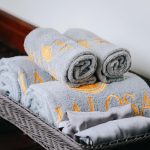Are you curious about the width of cotton quilting fabric? Look no further! In this article, we will explore the basics of cotton quilting fabric width and the various options available.
You will gain a better understanding of the standard measurements and learn about the benefits of wide cotton quilting fabric.
We will also discuss when and why you might choose narrow cotton quilting fabric. Plus, we’ll provide expert tips for working with different widths.
Let’s dive in and discover the world of cotton quilting fabric widths!
Table of Contents
The Basics of Cotton Quilting Fabric Width
If you’re wondering about the width of cotton quilting fabric, it typically ranges from 42 to 44 inches. This range is considered standard for most quilting projects. However, there are some advantages to using wider fabric and challenges that come with narrower fabric.
One of the advantages of wide fabric is that it allows for larger quilt blocks and designs. With wider fabric, you can create larger quilt pieces without having to piece together multiple smaller pieces. This can save you time and effort when cutting and sewing your quilt. Additionally, wider fabric is also beneficial when working with patterns that require larger motifs or designs. It gives you more flexibility in choosing and positioning your fabric prints.
On the other hand, challenges can arise when working with narrow fabric. If your fabric is too narrow, you may have difficulty cutting out larger quilt pieces or fitting them together seamlessly. You may need to piece together multiple smaller sections, which can be time-consuming and may not result in a clean and cohesive look. Additionally, narrow fabric can limit your options when it comes to choosing patterns with larger motifs or designs.
Common Width Options for Cotton Quilting Fabric
You’ll commonly find different width options available for quilting fabric. When choosing the right fabric width for your project, it’s important to consider the size and design of your quilt. Here are the standard fabric widths that you can choose from:
| Fabric Width | Measurement |
|---|---|
| 42 inches | This is the most common width option for quilting fabric. It provides a good amount of fabric for most quilt designs and is widely available. |
| 44 inches | This slightly wider option gives you a bit more fabric to work with, which can be useful for larger quilts or projects with bigger blocks. |
| 108 inches | This is a wide fabric that is often referred to as "wide backing fabric." It is specifically designed for backing quilts without the need for piecing together multiple fabric panels. |
When selecting your fabric width, consider the size of your quilt top and whether you want to piece together multiple fabric panels or use a single piece for the backing. Additionally, think about the design elements of your quilt and how the fabric width will affect the overall look. By choosing the right fabric width, you can ensure that your quilting project turns out just the way you envision it.
Understanding the Standard Measurements of Cotton Quilting Fabric
To understand the standard measurements of quilting fabric, it’s helpful to know the different width options available.
Cotton quilting fabric typically comes in two standard width measurements: 44 inches and 108 inches.
The 44-inch width is the most common and widely available option. It is suitable for most quilting projects and allows for efficient cutting and piecing.
The 108-inch width, also known as wide backing fabric, is primarily used for quilt backing. This wider fabric eliminates the need for seaming multiple pieces together and provides a seamless finish for larger quilts.
It is essential to note that fabric variations can exist within these standard measurements. Some fabrics may have a slightly different width due to manufacturing variances or specific design requirements.
When purchasing quilting fabric, it is advisable to check the exact width measurement specified by the manufacturer or fabric supplier. This ensures that the fabric meets your project’s requirements and allows for accurate planning and cutting.
Exploring the Benefits of Wide Cotton Quilting Fabric
When considering the benefits of using wider fabric for your quilting projects, it’s important to note that it eliminates the need for seaming multiple pieces together. This advantage not only saves you time and effort but also creates a more seamless and consistent look to your quilt.
Wide cotton quilting fabric offers versatility in terms of design options as well. With a wider fabric, you have more room to work with and can easily create larger blocks or panels for your quilt. This allows for more intricate patterns and designs, giving your quilt a unique and eye-catching appeal.
Additionally, wider fabric allows you to showcase larger prints or motifs without having to worry about them being cut off or distorted by seams. This is particularly advantageous when working with fabrics that have bold or elaborate designs.
Narrow Cotton Quilting Fabric: When and Why to Choose It
Narrow quilting fabric offers a different aesthetic and can be a great choice for projects that require more precision and intricate detailing. When it comes to narrow cotton quilting fabric, there are both advantages and disadvantages to consider.
Advantages of narrow cotton quilting fabric:
- More control: The narrow width allows for greater control over your stitches and design, making it ideal for intricate patterns and detailed work.
- Less waste: With a narrower fabric, you can purchase just the amount you need, reducing waste and saving money.
- Versatility: Narrow fabric can be used for various quilting techniques, such as sashing, borders, and binding.
- Different design possibilities: The narrower width can inspire unique design choices and create a visually interesting quilt.
Disadvantages of narrow cotton quilting fabric:
- Limited pattern availability: Some fabric patterns may not come in narrow widths, limiting your options.
- More seams: If you’re working on a larger project, you may need to sew multiple narrow strips together, resulting in more seams.
To find the right width for your quilting project, consider the level of detail you want to achieve and the specific design elements you have in mind. Narrow cotton quilting fabric can be a wonderful choice for adding precision and intricacy to your quilts.
Wide Vs. Narrow Cotton Quilting Fabric: Pros and Cons
Consider the advantages and disadvantages of using wide and narrow fabric for your quilting projects. When it comes to cotton quilting fabric, the width of the fabric can make a difference in both cost and design possibilities.
Let’s start with a cost comparison between wide and narrow cotton quilting fabric. Wide fabric typically comes in widths of 108 inches, while narrow fabric is usually 42-44 inches wide. The wider fabric allows you to cover a larger area with fewer seams, which can save you money on fabric and reduce the time spent on piecing. On the other hand, narrow fabric may be more budget-friendly if you only need a small amount of fabric for your project.
Now let’s talk about the design possibilities that wide cotton quilting fabric offers. With the wider width, you have more room to showcase large-scale prints and motifs without having to piece them together. This can create a dramatic and visually stunning effect in your quilts. Narrow fabric, on the other hand, may require more piecing and creativity to achieve the desired design.
In conclusion, when deciding between wide and narrow cotton quilting fabric, consider the cost implications and the design possibilities that each option offers. Choose the width that best suits your budget and design vision for your quilting projects.
| Aspect | Wide Fabric | Narrow Fabric |
|---|---|---|
| Cost | $$ | $ |
| Design | More room | More piecing |
| for large- | and creativity | |
| scale prints |
Expert Tips for Working With Different Widths of Cotton Quilting Fabric
When it comes to optimal fabric widths for quilting, there are a few key points to consider.
First, wider fabrics can be more convenient as they require fewer seams and result in a smoother finished product.
However, narrower fabrics can be more cost-effective, especially if you are working on a small project.
When handling fabric variations, it’s important to take note of any potential differences in shrinkage or stretchiness, as this can affect the overall outcome of your quilt.
Optimal Fabric Widths
The optimal fabric widths for cotton quilting fabric can vary depending on the specific project. When choosing the right fabric width, there are a few things to consider:
-
Quilt Size: Larger quilts will require wider fabric to ensure you have enough material to work with.
-
Pattern Repeat: If your quilt pattern has a large repeat, you may need wider fabric to ensure you can cut and match the pattern properly.
-
Seam Allowance: Consider the amount of fabric you need to accommodate for seam allowances when determining the optimal width.
-
Personal Preference: Some quilters prefer working with narrower fabric widths for easier handling and maneuverability.
Handling Fabric Variations
To handle fabric variations effectively, it is important to measure and plan ahead for a successful project. Different materials have different properties and characteristics, so it is crucial to consider factors such as the weight, drape, and stretch of the fabric. Take note of any specific care instructions for the fabric you choose, as some fabrics may require special handling or cleaning techniques to maintain their quality.
Before starting your project, always prewash and press your fabric to prevent shrinkage and ensure accurate measurements. Additionally, it is helpful to use pattern weights or pins to secure the fabric before cutting. By taking these steps, you can ensure that your fabric variations are handled properly, leading to a successful and well-executed project.
Conclusion
In conclusion, when it comes to cotton quilting fabric, it’s important to consider the width options available.
Whether you choose wide or narrow fabric, each option has its own benefits and drawbacks. Wide fabric can be advantageous for larger projects and offers more design possibilities. It allows you to cover a larger area without having to sew multiple pieces together. This can save you time and effort. Additionally, wide fabric is great for showcasing large-scale prints or intricate patterns.
On the other hand, narrow fabric is suitable for smaller projects. It requires less cutting and can be more cost-effective, especially if you only need a small amount of fabric. Narrow fabric also tends to be easier to handle and maneuver when quilting.
By understanding the standard measurements and considering your specific needs, you can make an informed decision on which width of cotton quilting fabric is best for your next project.
- How Does Ring Spun Cotton Affect Garment Fit and Shape Retention? - August 13, 2024
- What Are the Challenges in Producing Ring Spun Cotton? - August 13, 2024
- Is Ring Spun Cotton Suitable for Plus-Size Clothing? - August 13, 2024



